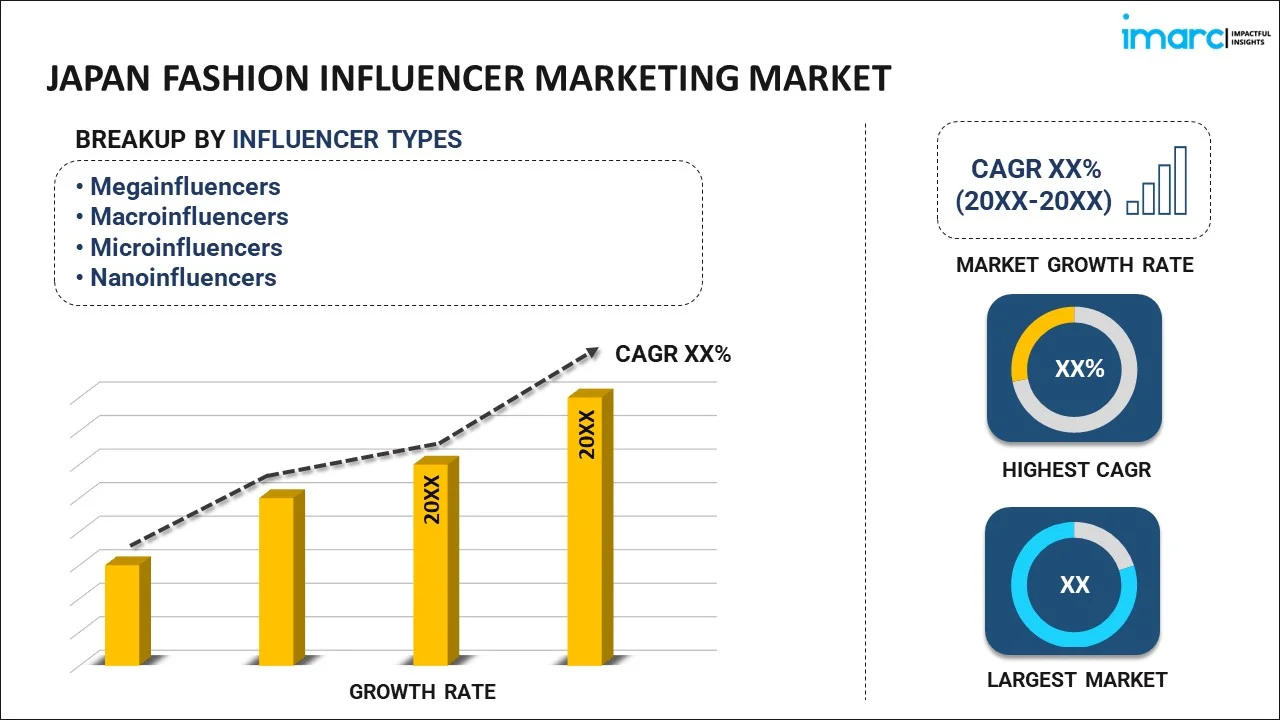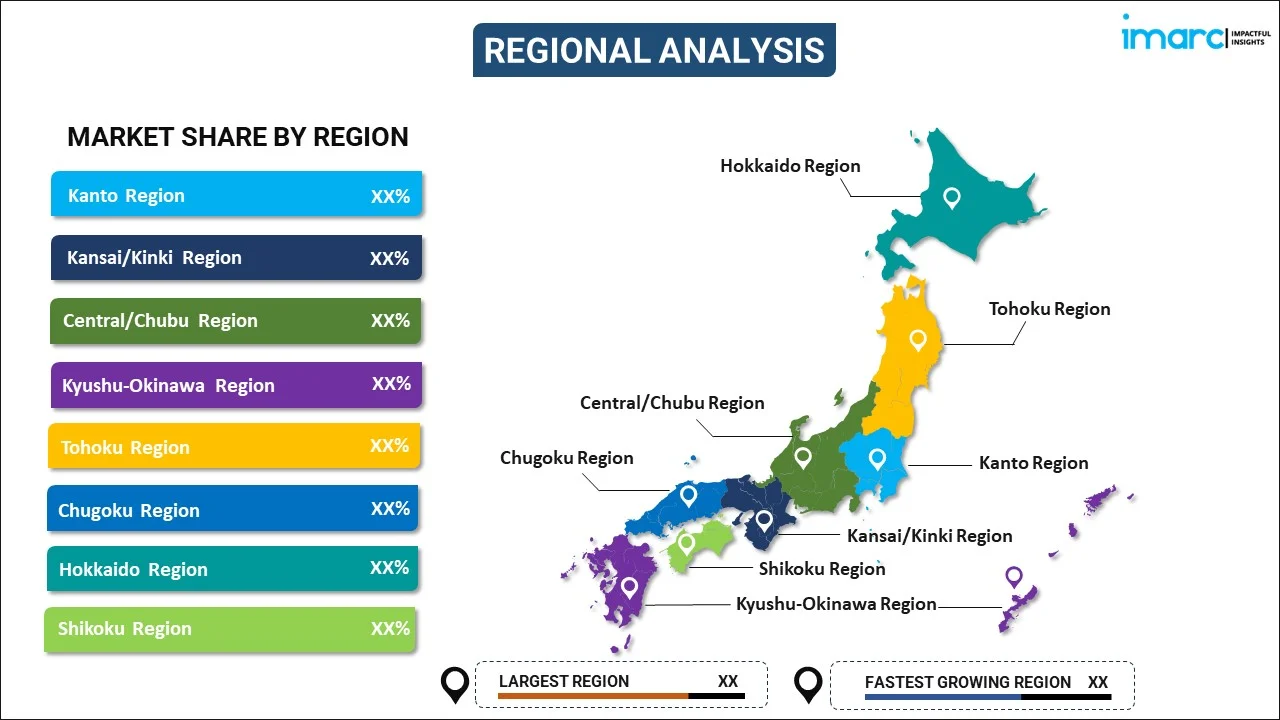
Japan Fashion Influencer Marketing Market Report by Influencer Type (Megainfluencers, Macroinfluencers, Microinfluencers, Nanoinfluencers), Fashion Type (Beauty and Cosmetics, Apparels, Jewelry and Accessories), and Region 2025-2033
Market Overview:
Japan fashion influencer marketing market size reached USD 400 Million in 2024. Looking forward, IMARC Group expects the market to reach USD 840 Million by 2033, exhibiting a growth rate (CAGR) of 8.54% during 2025-2033. The rising trend towards creating localized content to cater to domestic fashion preferences, increasing use of data analytics to refine content strategies, and thriving e-commerce industry represent some of the key factors driving the market.
|
Report Attribute
|
Key Statistics
|
|---|---|
|
Base Year
|
2024 |
|
Forecast Years
|
2025-2033
|
|
Historical Years
|
2019-2024
|
| Market Size in 2024 | USD 400 Million |
| Market Forecast in 2033 | USD 840 Million |
| Market Growth Rate (2025-2033) | 8.54% |
Fashion influencers marketing are establishing credibility and authority in the fashion industry through their expertise, style, and online presence. They use various social media platforms and content creation to inspire and guide their followers in matters of fashion, beauty, and style choices. They are known for their authenticity and unique personal style, which sets them apart from mainstream fashion sources. They have a strong online presence, where they share fashion-related content. They engage actively with their followers, responding to comments, providing fashion advice, and building a loyal community. They are trendsetters who often introduce and popularize new fashion trends and styles. They collaborate with brands and fashion labels, promoting products and services to their audience. They excel in visual storytelling, creating aesthetically pleasing and engaging content, including photos and videos. They offer their followers style inspiration and ideas, helping them make fashion choices that suit their preferences and body types. They introduce and review fashion products, helping followers discover new brands and make informed purchasing decisions. They foster a sense of community among their followers, creating a supportive space for fashion enthusiasts to connect and share. They contribute to promoting diversity and inclusivity in the fashion industry by showcasing a wide range of styles and body types. They create communities of like-minded fashion enthusiasts, fostering connections and shared interests among followers.
Japan Fashion Influencer Marketing Market Trends:
The rising trend towards creating localized content to cater to domestic fashion preferences in Japan represents one of the primary factors favoring the market growth. This dual approach allows them to maintain relevance and authenticity in their home market while expanding their international reach. Furthermore, fashion influencers in Japan are focusing on diversity and inclusivity in fashion, advocating for the representation of different body types, genders, and styles. This inclusive approach resonates with a global audience seeking fashion that reflects a broader range of identities and expressions. Along with this, they are promoting eco-friendly brands and encouraging the adoption of sustainable fashion choices, aligning with the growing global emphasis on responsible fashion. Moreover, fashion brands in Japan are increasingly collaborating with fashion influencers to leverage their reach and credibility. These partnerships create a synergy between traditional fashion labels and modern, digitally connected fashion influencers, resulting in innovative marketing campaigns and product promotions. Besides this, the influencers are increasingly involved in e-commerce platforms, launching their own fashion lines and collaborating with online retailers. This integration provides a seamless shopping experience for their followers, contributing to thriving e-commerce industry in the country. In addition, they are increasingly employing data analytics to refine their content strategies and attract a wider consumer base. They use insights into audience behavior and preferences to tailor their content and collaborations, ensuring that their fashion recommendations resonate with their followers.
Japan Fashion Influencer Marketing Market Segmentation:
IMARC Group provides an analysis of the key trends in each segment of the market, along with forecasts at the country level for 2025-2033. Our report has categorized the market based on influencer type and fashion type.
Influencer Type Insights:

- Megainfluencers
- Macroinfluencers
- Microinfluencers
- Nanoinfluencers
The report has provided a detailed breakup and analysis of the market based on the influencer type. This includes megainfluencers, macroinfluencers, microinfluencers, and nanoinfluencers.
Fashion Type Insights:
- Beauty and Cosmetics
- Apparels
- Jewelry and Accessories
A detailed breakup and analysis of the market based on the fashion type have also been provided in the report. This includes beauty and cosmetics, apparels, and jewelry and accessories.
Regional Insights:

- Kanto Region
- Kansai/Kinki Region
- Central/ Chubu Region
- Kyushu-Okinawa Region
- Tohoku Region
- Chugoku Region
- Hokkaido Region
- Shikoku Region
The report has also provided a comprehensive analysis of all the major regional markets, which include Kanto Region, Kansai/Kinki Region, Central/ Chubu Region, Kyushu-Okinawa Region, Tohoku Region, Chugoku Region, Hokkaido Region, and Shikoku Region.
Competitive Landscape:
The market research report has also provided a comprehensive analysis of the competitive landscape. Competitive analysis such as market structure, key player positioning, top winning strategies, competitive dashboard, and company evaluation quadrant has been covered in the report. Also, detailed profiles of all major companies have been provided.
Japan Fashion Influencer Marketing Market Report Coverage:
| Report Features | Details |
|---|---|
| Base Year of the Analysis | 2024 |
| Historical Period | 2019-2024 |
| Forecast Period | 2025-2033 |
| Units | Million USD |
| Scope of the Report | Exploration of Historical Trends and Market Outlook, Industry Catalysts and Challenges, Segment-Wise Historical and Future Market Assessment:
|
| Influencer Types Covered | Megainfluencers, Macroinfluencers, Microinfluencers, Nanoinfluencers |
| Fashion Types Covered | Beauty and Cosmetics, Apparels, Jewelry and Accessories |
| Regions Covered | Kanto Region, Kansai/Kinki Region, Central/ Chubu Region, Kyushu-Okinawa Region, Tohoku Region, Chugoku Region, Hokkaido Region, Shikoku Region |
| Customization Scope | 10% Free Customization |
| Post-Sale Analyst Support | 10-12 Weeks |
| Delivery Format | PDF and Excel through Email (We can also provide the editable version of the report in PPT/Word format on special request) |
Key Questions Answered in This Report:
- How has the Japan fashion influencer marketing market performed so far and how will it perform in the coming years?
- What has been the impact of COVID-19 on the Japan fashion influencer marketing market?
- What is the breakup of the Japan fashion influencer marketing market on the basis of influencer type?
- What is the breakup of the Japan fashion influencer marketing market on the basis of fashion type?
- What are the various stages in the value chain of the Japan fashion influencer marketing market?
- What are the key driving factors and challenges in the Japan fashion influencer marketing?
- What is the structure of the Japan fashion influencer marketing market and who are the key players?
- What is the degree of competition in the Japan fashion influencer marketing market?
Key Benefits for Stakeholders:
- IMARC’s industry report offers a comprehensive quantitative analysis of various market segments, historical and current market trends, market forecasts, and dynamics of the Japan fashion influencer marketing market from 2019-2033.
- The research report provides the latest information on the market drivers, challenges, and opportunities in the Japan fashion influencer marketing market.
- Porter's five forces analysis assist stakeholders in assessing the impact of new entrants, competitive rivalry, supplier power, buyer power, and the threat of substitution. It helps stakeholders to analyze the level of competition within the Japan fashion influencer marketing industry and its attractiveness.
- Competitive landscape allows stakeholders to understand their competitive environment and provides an insight into the current positions of key players in the market.
Need more help?
- Speak to our experienced analysts for insights on the current market scenarios.
- Include additional segments and countries to customize the report as per your requirement.
- Gain an unparalleled competitive advantage in your domain by understanding how to utilize the report and positively impacting your operations and revenue.
- For further assistance, please connect with our analysts.
 Inquire Before Buying
Inquire Before Buying
 Speak to an Analyst
Speak to an Analyst
 Request Brochure
Request Brochure
 Request Customization
Request Customization




.webp)




.webp)












